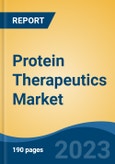Speak directly to the analyst to clarify any post sales queries you may have.
10% Free customizationThis report comes with 10% free customization, enabling you to add data that meets your specific business needs.
Produced through techniques like recombinant DNA technology and bioprocessing, protein therapeutics are known for their high specificity and minimal off-target effects compared to traditional small-molecule drugs. With ongoing innovations in protein engineering, such as antibody-drug conjugates and bispecific antibodies, the therapeutic potential of proteins continues to expand. The growing global burden of age-related diseases, including cardiovascular and autoimmune disorders, is fueling demand for these advanced therapies. Additionally, the rise in biosimilars, advances in genomics, and healthcare expansion in developing economies are contributing to market growth by improving treatment accessibility and personalization.
Key Market Drivers
Advancements in Protein Engineering
Protein engineering technologies have greatly expanded the potential of therapeutic proteins. Techniques such as directed evolution replicate natural selection in the lab to generate optimized proteins with improved stability, activity, or specificity. Computational modeling and rational design allow researchers to predict structural and functional changes in proteins, accelerating development.In 2025, Capgemini launched a generative AI-driven method using a protein large language model (pLLM) to predict optimal protein variants - highlighting the convergence of biotechnology and AI. Innovations in antibody engineering have produced monoclonal antibodies, bispecific antibodies, and antibody-drug conjugates (ADCs), which provide targeted and potent treatment options. Fusion proteins, combining functional protein domains, enhance half-life and therapeutic action. These advances enable the creation of tailored therapies for oncology, immunology, and rare diseases, driving demand across healthcare sectors.
Key Market Challenges
Manufacturing Complexities
Protein therapeutics require highly controlled and complex manufacturing environments. These biologics must maintain specific three-dimensional structures, undergo correct folding, and have precise post-translational modifications. Cell-based systems such as CHO cells are commonly used, but developing and optimizing these systems can be labor-intensive and time-consuming.Upstream processing, including cell culture, must manage strict parameters, while downstream purification processes require multiple steps to ensure purity and remove contaminants. Quality assurance demands advanced analytical tools to verify protein identity and potency. Scaling up production from lab to commercial levels introduces additional challenges in maintaining consistency and regulatory compliance. Variability in regional manufacturing and stringent GMP guidelines further complicate global operations. These complexities underscore the high cost and technical barriers in producing protein-based therapies.
Key Market Trends
Growth in Green and Energy-Efficient Elevators
(Not applicable for this section. Replaced with relevant trend below.)Rise of Personalized and Precision Protein Therapies
The integration of genomics, biomarker profiling, and next-generation sequencing is fueling the growth of personalized protein therapeutics. These approaches allow the development of drugs tailored to specific genetic or molecular profiles, enhancing treatment effectiveness and reducing adverse effects. Biopharmaceutical companies are investing in precision biologics for conditions such as cancer, autoimmune disorders, and metabolic diseases. Immunotherapies - including CAR-T cells and immune checkpoint inhibitors - are leading the way, supported by robust clinical research and increasing regulatory approvals. Additionally, biosimilars are gaining traction by offering cost-effective alternatives to originator biologics, expanding access in cost-sensitive markets. This trend toward individualized treatment strategies is reshaping the therapeutic landscape and aligning with global healthcare goals to improve outcomes and reduce system-wide costs.Key Players Profiled in this Protein Therapeutics Market Report
- Amgen Inc.
- Eli Lilly and Company
- F. Hoffmann-La Roche Ltd.
- Johnson & Johnson Services, Inc
- Merck KGaA
- Pfizer Inc.
- AstraZeneca Plc
- Teva Pharmaceutical Industries Ltd
- Bristol-Myers Squibb Company
- AbbVie Inc.
Report Scope:
In this report, the Global Protein Therapeutics Market has been segmented into the following categories, in addition to the industry trends which have also been detailed below:Protein Therapeutics Market, by Protein Function:
- Enzymatic & Regulatory
- Protein Diagnostics
- Vaccines
Protein Therapeutics Market, by Product Type:
- Blood Clotting Factor
- Erythropoietin
- Follicle Stimulating Hormone
- G-CSF
- Insulin
- Interferons
- Monoclonal Antibodies
Protein Therapeutics Market, by Region:
- North America
- United States
- Canada
- Mexico
- Asia-Pacific
- China
- India
- South Korea
- Australia
- Japan
- Europe
- Germany
- France
- United Kingdom
- Spain
- Italy
- South America
- Brazil
- Argentina
- Colombia
- Middle East & Africa
- South Africa
- Saudi Arabia
- UAE
Competitive Landscape
Company Profiles: Detailed analysis of the major companies present in the Global Protein Therapeutics Market.Available Customizations:
With the given market data, the publisher offers customizations according to a company's specific needs. The following customization options are available for the report.Company Information
- Detailed analysis and profiling of additional market players (up to five).
This product will be delivered within 1-3 business days.
Table of Contents
Companies Mentioned
The leading companies profiled in this Protein Therapeutics market report include:- Amgen Inc.
- Eli Lilly and Company.
- F. Hoffmann-La Roche Ltd.
- Johnson & Johnson Services, Inc
- Merck KGaA
- Pfizer Inc
- AstraZeneca Plc.
- Teva Pharmaceutical Industries Ltd
- Bristol-Myers Squibb Company
- AbbVie Inc.
Table Information
| Report Attribute | Details |
|---|---|
| No. of Pages | 190 |
| Published | May 2025 |
| Forecast Period | 2024 - 2030 |
| Estimated Market Value ( USD | $ 271.26 Billion |
| Forecasted Market Value ( USD | $ 399.31 Billion |
| Compound Annual Growth Rate | 6.8% |
| Regions Covered | Global |
| No. of Companies Mentioned | 11 |









